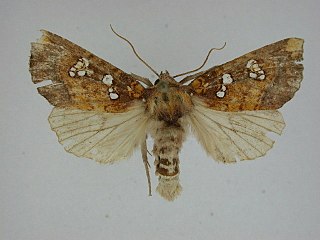Dichagyris kyune is a species of cutworm or dart moth in the family Noctuidae. It was first described by William Barnes in 1904 and it is found in North America.
Dichagyris lobato is a species of cutworm or dart moth in the family Noctuidae. It was first described by William Barnes in 1904 and it is found in North America.
Dichagyris socorro is a species of cutworm or dart moth in the family Noctuidae. It was first described by William Barnes in 1904 and it is found in North America.
Anarta inconcinna is a species of cutworm or dart moth in the family Noctuidae. It was first described by Smith in 1888 and it is found in North America.
Proxenus mendosa is a species of cutworm or dart moth in the family Noctuidae. It is found in North America.
Lacinipolia aileenae is a moth genus or species of cutworm or dart moth in the family Noctuidae. It is found in North America.
Properigea perolivalis is a species of cutworm or dart moth in the family Noctuidae. It was first described by William Barnes and James Halliday McDunnough in 1912 and it is found in North America.
Anarta obesula is a species of cutworm or dart moth in the family Noctuidae first described by Smith in 1904. It is found in North America.
Properigea costa, the barrens moth, is a species of cutworm or dart moth in the family Noctuidae. It was first described by William Barnes and Foster Hendrickson Benjamin in 1923 and it is found in North America.
Lacinipolia spiculosa is a species of cutworm or dart moth in the family Noctuidae. It is found in North America.
Protogygia polingi is a species of cutworm or dart moth in the family Noctuidae. It was first described by William Barnes and Foster Hendrickson Benjamin in 1922 and it is found in North America.
Orthosia tenuimacula is a species of cutworm or dart moth in the family Noctuidae first described by William Barnes and James Halliday McDunnough in 1913. It is found in North America.
Anarta fulgora is a species of cutworm or dart moth in the family Noctuidae first described by William Barnes and James Halliday McDunnough in 1918. It is found in North America.
Homorthodes gigantoides is a species of cutworm or dart moth in the family Noctuidae first described by William Barnes and James Halliday McDunnough in 1912. It is found in North America.
Caradrina beta is a species of cutworm or dart moth in the family Noctuidae first described by William Barnes and Foster Hendrickson Benjamin in 1926. It is found in North America.
Mesapamea arbora is a species of cutworm or dart moth in the family Noctuidae first described by William Barnes and James Halliday McDunnough in 1912. It is found in North America.
Leucania incognita is a species of cutworm or dart moth in the family Noctuidae first described by William Barnes and James Halliday McDunnough in 1918. It is found in North America.
Xylomoia chagnoni, the Chang borer moth, is a species of cutworm or dart moth in the family Noctuidae. It was first described by William Barnes and James Halliday McDunnough in 1917 and it is found in North America.

Papaipema rutila, the mayapple borer moth, is a species of cutworm or dart moth in the family Noctuidae. It is found in North America.
Anarta alta is a species of cutworm or dart moth in the family Noctuidae first described by William Barnes and Foster Hendrickson Benjamin in 1924. It is found in North America.
